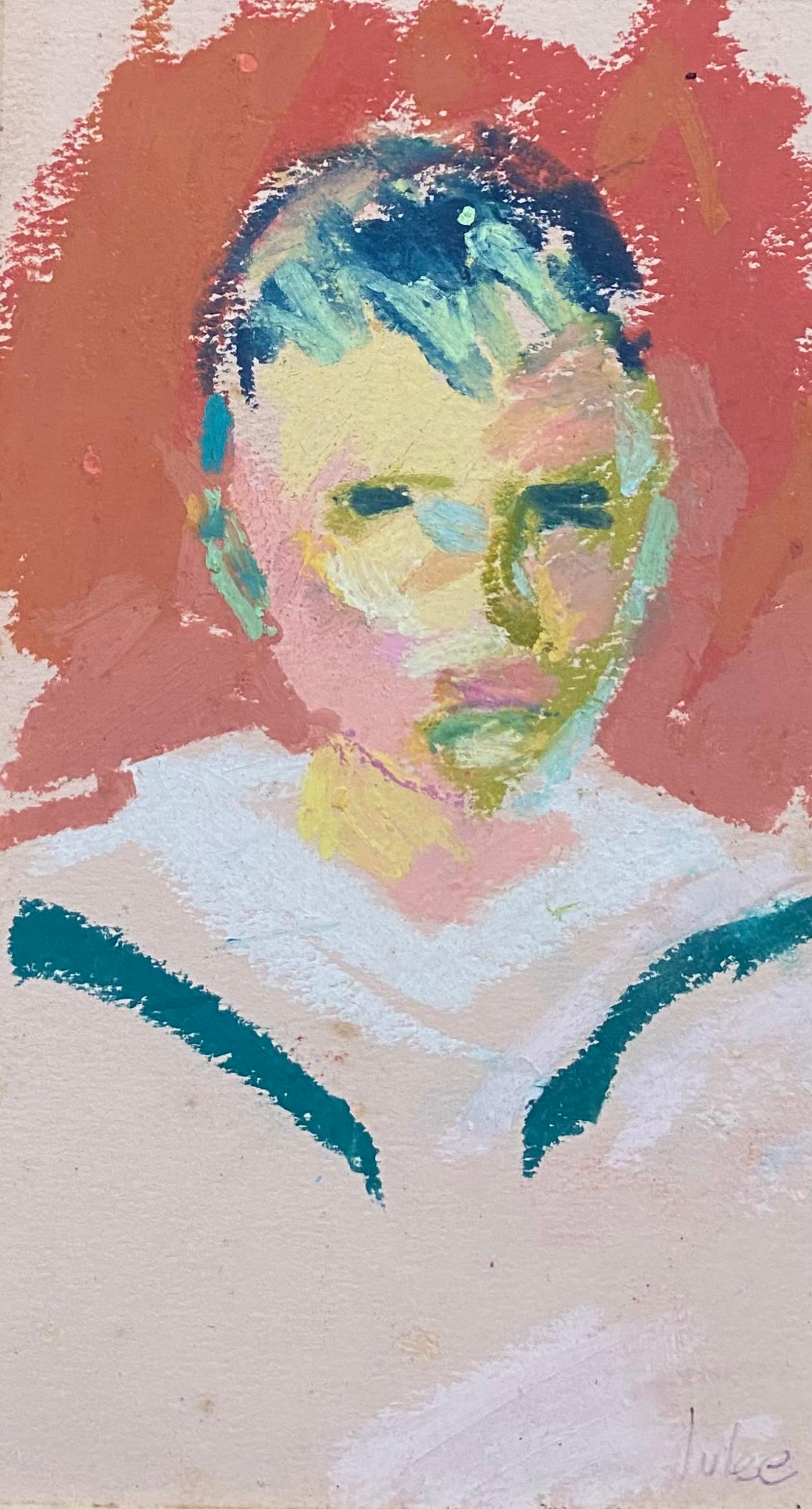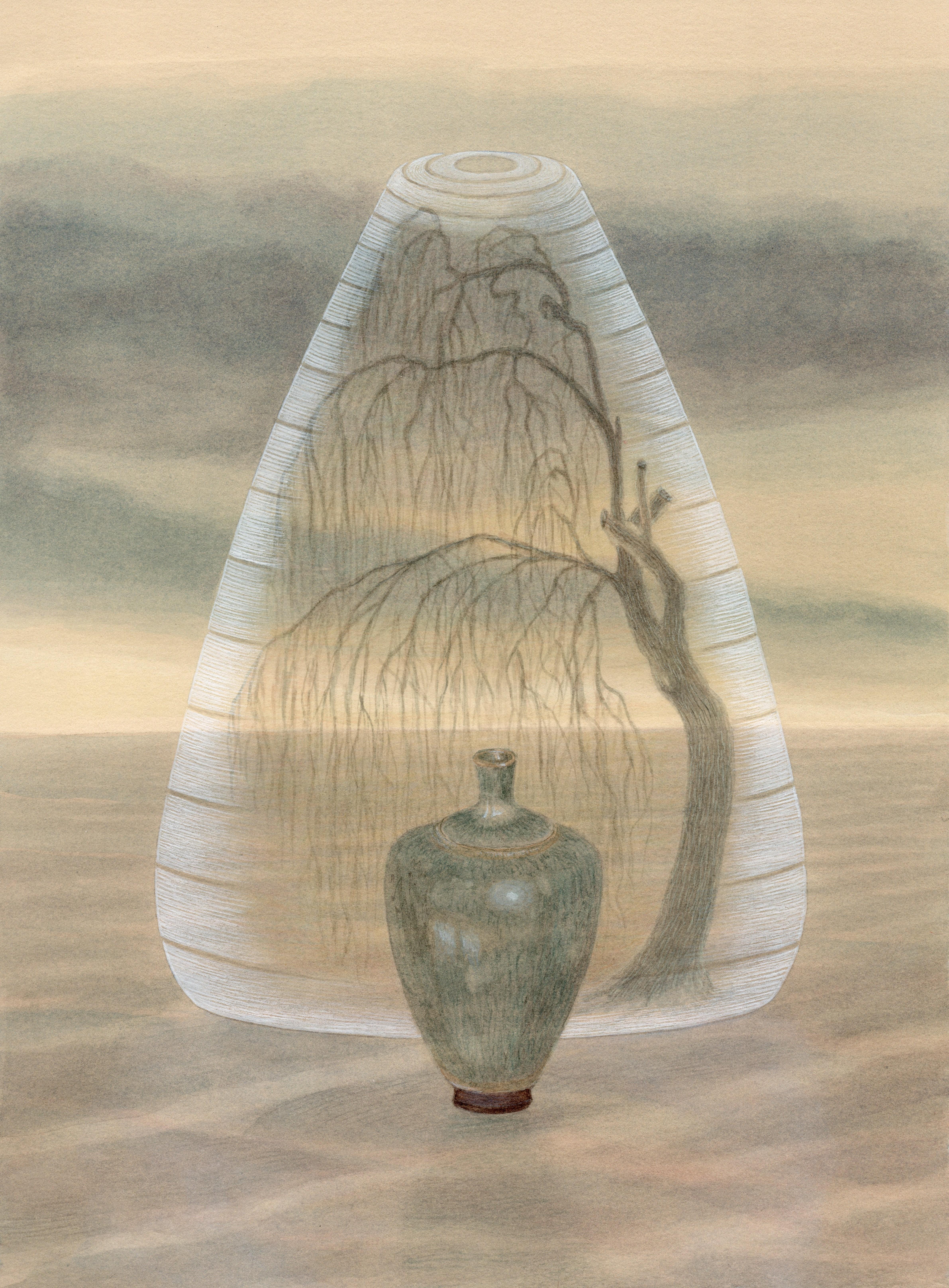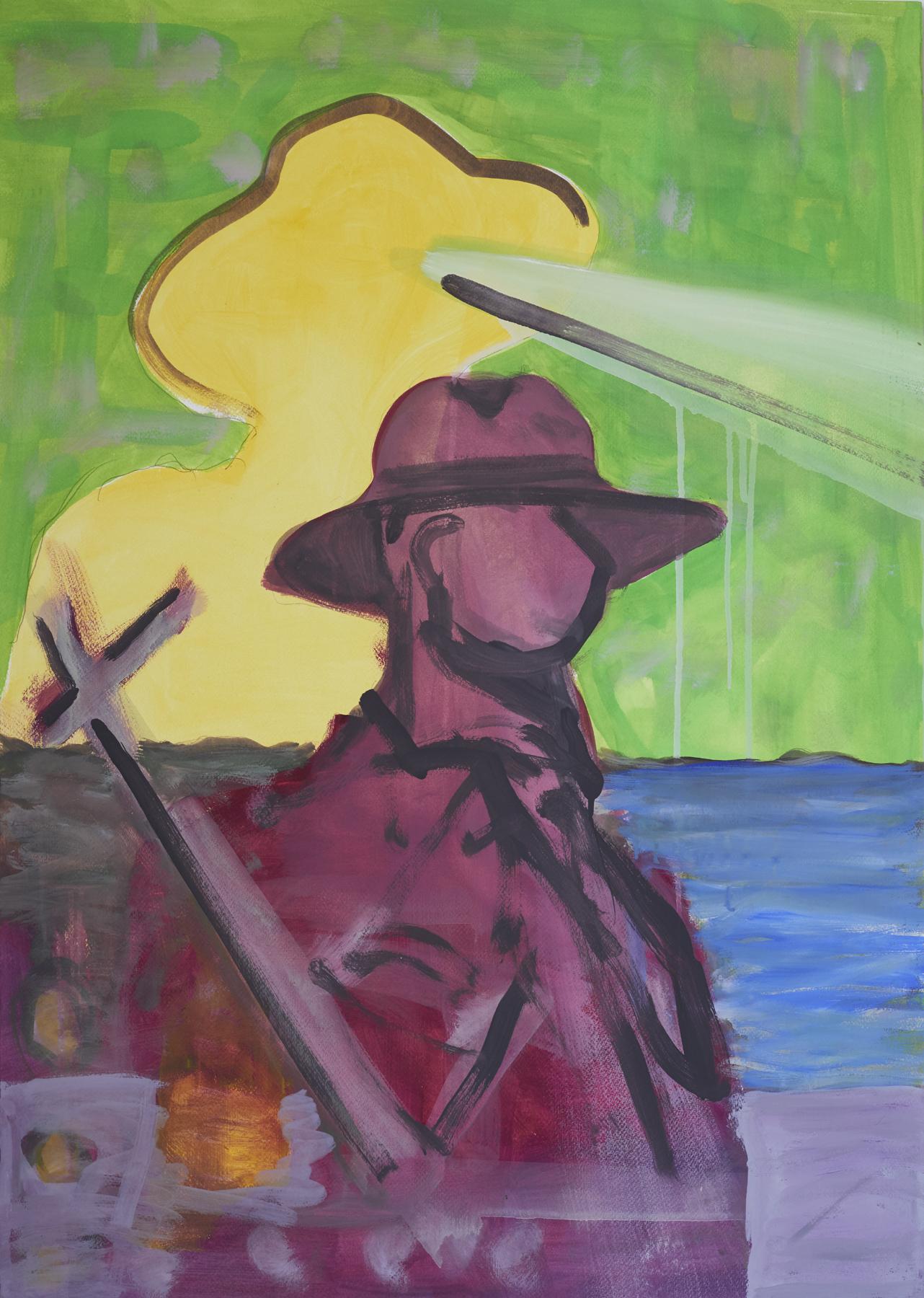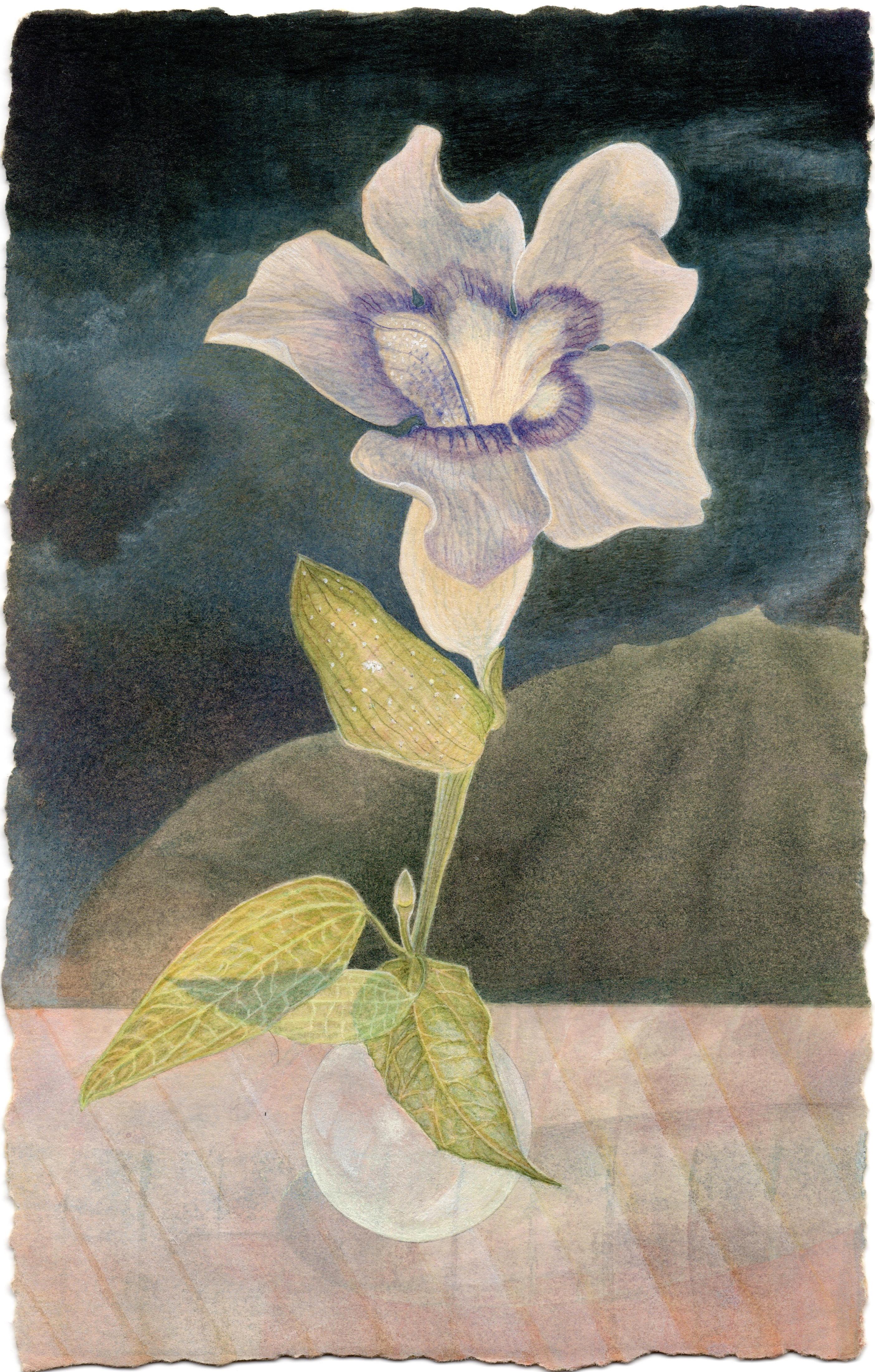Items Similar to "New England Landscape, " James Grabowski, View of Connecticut Hills in the Sun
Want more images or videos?
Request additional images or videos from the seller
1 of 5
James Grabowski"New England Landscape, " James Grabowski, View of Connecticut Hills in the Sun
About the Item
James L. Grabowski (American born 1944)
New England Landscape
Gouache on paper
27 1/2 x 39 1/2
Signed on the reverse
Has a plaque for Arches Paper Award
James Grabowski was born in New Britain, CT, and received his bachelor’s degree in 1966 from Central Connecticut State University. He continued his formal artistic training there, earning his MFA in 1968.
Following his graduation, he taught art for several years. After receiving a number of paintings commissions, he turned to his own work and devoted himself to painting full-time.
Grabowski maintains his studio in Marlborough, Connecticut, where he lives with his wife and daughter. He has received commissions for his paintings from more than 100 national and international corporations, and is in the permanent collections of numerous important collections including, Connecticut Public Television, the New Haven Symphony and the Hartford Graduate Center.
- Creator:James Grabowski (1944)
- Dimensions:Height: 31 in (78.74 cm)Width: 43 in (109.22 cm)
- Medium:
- Movement & Style:
- Period:
- Condition:
- Gallery Location:New York, NY
- Reference Number:1stDibs: LU184129920652
About the Seller
5.0
Platinum Seller
These expertly vetted sellers are 1stDibs' most experienced sellers and are rated highest by our customers.
Established in 2021
1stDibs seller since 2022
63 sales on 1stDibs
Typical response time: <1 hour
- ShippingRetrieving quote...Ships From: New York, NY
- Return PolicyA return for this item may be initiated within 3 days of delivery.
More From This SellerView All
- Five at the Rail, View of Racetrack and Crowd, Saratoga Springs, New YorkBy Anne DiggoryLocated in New York, NYAnne Diggory (b. 1951) Five at the Rail, Saratoga Springs Racecourse, New York, circa 1978 Watercolor on paper 4 3/4 x 6 inches Initialed lower right: Dig...Category
1970s Contemporary Landscape Drawings and Watercolors
MaterialsWatercolor, Paper
- Out of the Sun (Under the Racetrack Grandstand), Saratoga Springs, Anne DiggoryBy Anne DiggoryLocated in New York, NYAnne Diggory (b. 1951) Out of the Sun (Under the Racetrack Grandstand), 1978 Watercolor on paper 7 x 10 inches Signed and dated lower left Provenance: Ac...Category
1970s Contemporary Landscape Drawings and Watercolors
MaterialsPaper, Watercolor, Pencil
- "House on a Hill, " Clara Bell, Female Artist Landscape, American ImpressionismLocated in New York, NYClara Louise Bell (1886 - 1978) House on a Hill, circa 1935 Gouache on artist board 7 1/4 x 9 7/8 inches Clara Louise Bell (Mrs.Bela Janowsky) was b...Category
1930s American Impressionist Landscape Paintings
MaterialsGouache, Board
- "Tugboat at Dock, " Reginald Marsh, Modern WPA Industrial ShipBy Reginald MarshLocated in New York, NYReginald Marsh Tugboat at Dock, circa 1937 Signed lower right Watercolor and pencil on paper 13 3/4 x 20 inches Housed in a Lowy frame. Provenance: Sotheby'...Category
1930s Modern Landscape Paintings
MaterialsPaper, Watercolor, Pencil
- "Train Station, " Max Kuehne, Industrial City Scene, American ImpressionismBy Max KuehneLocated in New York, NYMax Kuehne (1880 - 1968) Train Station, circa 1910 Watercolor on paper 8 1/4 x 10 1/4 inches Signed lower right Provenance: Private Collection, Illinois Max Kuehne was born in Halle, Germany on November 7, 1880. During his adolescence the family immigrated to America and settled in Flushing, New York. As a young man, Max was active in rowing events, bicycle racing, swimming and sailing. After experimenting with various occupations, Kuehne decided to study art, which led him to William Merritt Chase's famous school in New York; he was trained by Chase himself, then by Kenneth Hayes Miller. Chase was at the peak of his career, and his portraits were especially in demand. Kuehne would have profited from Chase's invaluable lessons in technique, as well as his inspirational personality. Miller, only four years older than Kuehne, was another of the many artists to benefit from Chase's teachings. Even though Miller still would have been under the spell of Chase upon Kuehne's arrival, he was already experimenting with an aestheticism that went beyond Chase's realism and virtuosity of the brush. Later Miller developed a style dependent upon volumetric figures that recall Italian Renaissance prototypes. Kuehne moved from Miller to Robert Henri in 1909. Rockwell Kent, who also studied under Chase, Miller, and Henri, expressed what he felt were their respective contributions: "As Chase had taught us to use our eyes, and Henri to enlist our hearts, Miller called on us to use our heads." (Rockwell Kent, It's Me O Lord: The Autobiography of Rockwell Kent. New York: Dodd, Mead and Co., 1955, p. 83). Henri prompted Kuehne to search out the unvarnished realities of urban living; a notable portion of Henri's stylistic formula was incorporated into his work. Having received such a thorough foundation in art, Kuehne spent a year in Europe's major art museums to study techniques of the old masters. His son Richard named Ernest Lawson as one of Max Kuehne's European traveling companions. In 1911 Kuehne moved to New York where he maintained a studio and painted everyday scenes around him, using the rather Manet-like, dark palette of Henri. A trip to Gloucester during the following summer engendered a brighter palette. In the words of Gallatin (1924, p. 60), during that summer Kuehne "executed some of his most successful pictures, paintings full of sunlight . . . revealing the fact that he was becoming a colorist of considerable distinction." Kuehne was away in England the year of the Armory Show (1913), where he worked on powerful, painterly seascapes on the rocky shores of Cornwall. Possibly inspired by Henri - who had discovered Madrid in 1900 then took classes there in 1906, 1908 and 1912 - Kuehne visited Spain in 1914; in all, he would spend three years there, maintaining a studio in Granada. He developed his own impressionism and a greater simplicity while in Spain, under the influence of the brilliant Mediterranean light. George Bellows convinced Kuehne to spend the summer of 1919 in Rockport, Maine (near Camden). The influence of Bellows was more than casual; he would have intensified Kuehne's commitment to paint life "in the raw" around him. After another brief trip to Spain in 1920, Kuehne went to the other Rockport (Cape Ann, Massachusetts) where he was accepted as a member of the vigorous art colony, spearheaded by Aldro T. Hibbard. Rockport's picturesque ambiance fulfilled the needs of an artist-sailor: as a writer in the Gloucester Daily Times explained, "Max Kuehne came to Rockport to paint, but he stayed to sail." The 1920s was a boom decade for Cape Ann, as it was for the rest of the nation. Kuehne's studio in Rockport was formerly occupied by Jonas Lie. Kuehne spent the summer of 1923 in Paris, where in July, André Breton started a brawl as the curtain went up on a play by his rival Tristan Tzara; the event signified the demise of the Dada movement. Kuehne could not relate to this avant-garde art but was apparently influenced by more traditional painters — the Fauves, Nabis, and painters such as Bonnard. Gallatin perceived a looser handling and more brilliant color in the pictures Kuehne brought back to the States in the fall. In 1926, Kuehne won the First Honorable Mention at the Carnegie Institute, and he re-exhibited there, for example, in 1937 (Before the Wind). Besides painting, Kuehne did sculpture, decorative screens, and furniture work with carved and gilded molding. In addition, he designed and carved his own frames, and John Taylor Adams encouraged Kuehne to execute etchings. Through his talents in all these media he was able to survive the Depression, and during the 1940s and 1950s these activities almost eclipsed his easel painting. In later years, Kuehne's landscapes and still-lifes show the influence of Cézanne and Bonnard, and his style changed radically. Max Kuehne died in 1968. He exhibited his work at the National Academy of Design, the Art Institute of Chicago, the Carnegie Institute in Pittsburgh, the Memorial Art Gallery of the University of Rochester, and in various New York City galleries. Kuehne's works are in the following public collections: the Detroit Institute of Arts (Marine Headland), the Whitney Museum (Diamond Hill...Category
1910s American Impressionist Landscape Drawings and Watercolors
MaterialsPaper, Watercolor
- "New York from the Ferry" John Marin, American Modernism Watercolor, CityscapeBy John MarinLocated in New York, NYJohn Marin New York from the Ferry, 1914 Signed and dated lower right Watercolor and graphite on paper 11 x 12 3/4 inches Provenance: An American Place, New York Kennedy Galleries, Inc., New York Christie's, New York, March 16, 1990, Lot 278 Private Collection (acquired from the above) Sotheby's New York, American Paintings, Drawings, & Sculpture, October 2, 2014, Lot 10 A major figure in early twentieth-century modernism, John Marin captured the colliding energies of the American urban scene and the vibrant contrasts of natural elements in the coastal landscape of Maine and other countryside locales. As one of the premier watercolorists of his era, Marin developed a light, spontaneous style ideally suited to conveying the freshness and flux of city and country experience -- his watercolors are often considered to match in strength those created by Winslow Homer in previous century. At the same time, Marin's sensitivity to mass, form, color, and line and their dynamic interchanges provided a precedent for the Abstract Expressionist movement of the late 1950s. Marin was born in Rutherford, New Jersey, to a family of European descent. After studying mechanical drawing and mathematics for half a year at the Stevens Institute of Technology in New York, Marin worked as a draftsman for several architects. It was not until he was almost thirty years old that he began to study art. He enrolled at the Pennsylvania Academy of the Fine Arts in Philadelphia from 1899 to 1901, and at the Art Students League in New York from 1901 to 1903, where his teachers were William Merritt Chase and Frank Vincent Dumond. While Marin was attending the League, the radical ideas of Arthur Wesley Dow were being disseminated and had an impact on the direction Marin would soon take in his art. Marin left for Europe in 1905. The next five years, which he spent abroad, were of tremendous importance to his career. He became a significant figure in the expatriate community in Paris, frequenting the Dôme, a café that served as a meeting place for artists and writers. While in Europe, Marin visited the Louvre and the Rijksmuseum in Amsterdam and, despite his claims that he had been indifferent to the Paris art world, he undoubtedly became aware of the art of Paul Cézanne and Henri Matisse. The works Marin created in Europe most strongly reflect the influence of James McNeill Whistler, especially the pastels he rendered in Venice. In the summer of 1909, Marin met Alfred Stieglitz in Paris. In February of the next year, Marin's work was shown along with that of Alfred Maurer at Stieglitz's gallery, 291. After returning to America in the following year, Marin became one of the most consistent members of Stieglitz's inner circle, showing at all three of his galleries -- 291, The Intimate Gallery, and An American Place. After 1910, Marin developed the routine that he would follow for the rest of his life, creating paintings, drawings, and prints in New York City and surrounding areas during the winter, and in the summer, traveling to the country, where he focused on the particular characteristics of the regions that he visited. He worked mainly in watercolor until 1928, when he began also to use oil. Marin never became purely abstract. He formulated a unique style melding influences of the art of the French Fauves, Cézanne, Matisse, and the French Cubists with a personal style of luminescent colors, agile brushwork, and a simultaneously delicate and strong handling. In city views, he used broken lines, a light touch, fluid color, and rhythmic compositions to convey what he described as the "great forces at work." He expressed the warring of the great and the small through relationships between masses. As he said, he sought to express the "pull forces" of the modern urban scene. Often portraying the new tall buildings of New York seen...Category
1910s American Modern Landscape Drawings and Watercolors
MaterialsPaper, Watercolor
You May Also Like
- "Outside, In" camping motif, watercolor and gouache, night scene, starsLocated in Philadelphia, PAThis piece titled "Outside, In" is an original artwork by Ash Limés Castellana and is made of gouache, watercolor, and pastel. This piece measures 8”h x 8”w framed. Founded in 1997...Category
21st Century and Contemporary Contemporary Landscape Drawings and Waterc...
MaterialsPastel, Watercolor, Gouache, Archival Paper
- “Artist Self Portrait”By Julee DockingLocated in Southampton, NYOriginal mixed media composed of watercolor and gouache on archival paper. Signed lower right. Condition is very good. Appears to be a self portrait of the artist. Circa 1970. Under glass. Framed in a contemporary gold frame Overall framed measurements are 12 by 10 inches. Provenance: A Sarasota, Florida estate. Julee Docking biography: Painter, Oil, Watercolor, Acrylic, Collage, Woodcuts, Charcoal, Mixedmedia, Sculptor, Clay, Mixed media. Born: Bethesda-Chevy Chase, Maryland Studied: Corcoran Art School-Washington DC High Museum,Atlanta ,GA and Private Lessons Taught: Painting and Sculpture in Atlanta and Sarasota Membership: National League of American Pen Women, Women's Caucus ofArt, Florida Artists Group member 1973 Petticoat Painters member 1975 Art Center Sarasota member 1972 Manatee Art Center Venice Art Center Artist Statement: I enjoy painting in all media, relying on "Chance" to help create the First Ecstatic Impression of either abstract or Realism Genres. A long time resident of Sarasota, Julee Docking has been listed in "A History of Visual Art in Sarasota" And was part of the fine Arts Society "Artist and Collectors Tour" in 1973 and again in 1988 AWARDS: Grumbacher Gold Medallion, Cornell Museum FL Hilton Leach...Category
1970s Contemporary Landscape Drawings and Watercolors
MaterialsArchival Paper, Watercolor, Gouache
- Willow - Botanical Watercolor & Gouache on Paper with Single Bud Vase and TreeBy Christina HaglidLocated in Chicago, ILA single bud vase, a willow tree seeming to grow inside a confined vessel, all appearing to float upon a sea of moving water are the subjects of Christ...Category
21st Century and Contemporary Contemporary Landscape Drawings and Waterc...
MaterialsWatercolor, Gouache, Archival Paper
- Nest, Highly Detailed Surreal Botanical, Watercolor & Gouache on Paper, FramedBy Christina HaglidLocated in Chicago, ILThis surreal landscape comes from the inner sanctum of artist Christina Haglid. Two paper orbs combine and reveal a portal to another dimension. The artist invites the viewer to take a closer look at nature, to question what is seen and to enter into a newly created world. Meticulous in her execution, Haglid uses watercolor as one might use a colored pencil. Layer upon layer of color is added to achieve this impressively detailed painting. The piece is matted and framed in a simple white frame measuring 20.25 x 16.75. Christina Haglid Nest, 2020 watercolor and gouache on paper 11h x 8w in 27.94h x 20.32w cm CMH051 Artist's Statement Tiny Sanctuaries There has always been an intersection between the process of writing and the act of painting in my work. It has somehow been my guide. In the last four years, during the making of this work, that connection intensified as I started writing short stories and flash fiction while taking online classes. I find the process of writing and painting so different in almost every way, but there is something freeing and generative in writing which helps my painting process. Or perhaps it's a reminder of what painting is for me - something intuitive that needs to be trusted. And what they do have in common is a desire to encapsulate and distill a single moment, a story, about the complexity of our emotions and experiences. At the heart of my work is the recurring depiction of perseverance, strength of will, and a subtle optimism. Symbolically through the objects, precarious situations depict a moment of possible difficulty, often involving the influence of nature. A paper crane left in the snow. A boat nearly filled to the brim, but not submerged and able to drain its own contents carefully. A slide alone at night...Category
21st Century and Contemporary Contemporary Landscape Drawings and Waterc...
MaterialsWatercolor, Gouache, Archival Paper
- Swiss Contemporary Art by Olivier Furter - Mensch IIILocated in Paris, IDFGouache on paper - Framed 102 x 72 x 3 cmCategory
2010s Contemporary Figurative Drawings and Watercolors
MaterialsPaper, Gouache
- Blue ThumbergiaBy Christina HaglidLocated in Chicago, ILChristina Haglid Artist's Statement I used to write a lot of poetry, and it has shaped the narrative process in my artwork. Now painting has replaced writing. Objects in the painting are considered like words placed on a page. I use flowers, manipulated objects, and architecture together in compositions to symbolize the subtle conversations and interactions between them. They are placed in imaginary landscapes that are inspired by actual places and travels. All the paintings are watercolor and gouache on stonehendge paper, and they are made up almost entirely of individual brushstrokes. EDUCATION 1993 M.F.A., Cranbrook Academy of Art 1991 B.F.A., Maryland Institute, College of Art 1990 Skowhegan School of Painting and Sculpture EXHIBITIONS 2015 "Gallery Group" Ann Nathan Gallery, Chicago, IL 2014 "Gallery Group" Ann Nathan Gallery, Chicago, IL 2013 "Gallery Group" Ann Nathan Gallery, Chicago, IL 2012 "Gallery Group" Ann Nathan Gallery, Chicago, IL 2011 “Gallery Group” Ann Nathan Gallery, Chicago, IL "Meticulous Details: Conservators' Paintings" The Architrouve, Chicago, IL 2010 “Art Chicago” Merchandise Mart, Ann Nathan Gallery, Chicago, IL 2009 “Botanica” Ann Nathan Gallery, Chicago, IL 2006 “Botanicus” Ann Nathan Gallery, Chicago, IL 2006 “Arts Botanica” Loyola University Museum of Art, Chicago, IL 2005 “Blumen: Group Show” Ann Nathan Gallery, Chicago, IL 2004-05 “Think Small” Illinois State Museum, IL [traveled] “Christina Haglid: Microworlds” Greenville...Category
21st Century and Contemporary Contemporary Landscape Drawings and Waterc...
MaterialsWatercolor, Gouache, Archival Paper
Recently Viewed
View AllMore Ways To Browse
England Landscape
Painting Of New England
Connecticut Painting
New England Landscape
Landscape Painting And New England
Connecticut Landscape
Connecticut Sign
New Haven
Landscape Painting Signed James
Vintage Graduation
James Hill
Award Plaque
James Havens
Black A White Photography
The American Art Galleries
The American Art Gallery
Original Artist Prints
Contemporary Painting Framed





